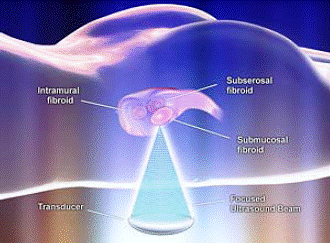MRgFUS (Magnetic Resonance Guided Focus Ultrasound) uses MRI and ultrasound to find your fibroids and then to apply ultrasound-generated energy to heat the fibroids up in order to destroy them.
This is not a surgical procedure and does not involve cuts or incisions. It is typically performed by an interventional radiologist.
What can I expect from the procedure?
This procedure aims to relieve abdominal pain and cramping, heavy menstrual bleeding, anaemia, distended stomachs, and constipation, which are caused by fibroids. Fibroid volume may be shrunk by 30 ± 24 % after 4 months.
What are the alternatives?
Other alternatives for relief of symptoms caused by fibroids include:
- For heavy menstrual bleeding: non-hormonal oral medications, or hormonal oral medications, or a hormonal coil (e.g. Mirena) or
- For bulk-related symptoms in addition to heavy bleeding: (i) minimum invasive procedure such as transcervical resection of fibroids (TCRF) or uterine artery embolisation (UAE/UFE) or TRFAM (Transcervical Radio Frequency Ablation of Myoma, or (ii) extensive surgery such as abdominal myomectomy, or (iii) a long-term permanent solution of hysterectomy.
How different is MRgFUS to other procedures for fibroids?
- MRgFUS is not an operation.
- It does not involve anaesthetic.
- No hospital stay (i.e. an outpatient procedure).
Am I suitable for this procedure?
MRgFUS is only suitable for small fibroids (larger than 3 cm and less than 10 cm) of average size less than 7 cm where the high intensity ultrasound energy does not pass through the bowel or bladder on its way to reach the fibroids.
Suitable fibroid types include:
- Submucosal that causes bleeding,
- Subserosal without narrow stalk that causes pressure/urinary symptoms.
When is this procedure unsuitable?
MRgFUS is unsuitable when you have:
- Fibroids over 10 cm/500 mls.
- Obstructions in the treatment beam path such as a scar (e.g. c-section), skin fold, bowel, intrauterine device or any hard implants;
- Fibroids that are close to sensitive organs such as the bowel or bladder;
- MRI related issues such as an allergy to contrast agent or metallic implants or overweight;
- Pregnancy;
- IUD;
- Cardiac, cerebrovascular, bleeding, haematological, neurological disorder or any pelvic infection.
I have multiple fibroids, is it still OK for me to have MRgFUS?
MRgFUS is not recommended for 6 or more symptomatic fibroids.
Will I still be able to have children afterwards?
There are only a handful of reports of pregnancy (mainly in cases of single fibroid ablations), currently, this procedure in NOT recommended for women who still want children.
What are the risks or complications of the procedure?
Risks and complications of MRgFUS are relatively low and include:
- Possible skin burns.
- Pain &/or swelling in the treated area.
- Back or leg pain.
- Nerve damage.
- Nausea.
- Abdominal cramping.
- Fever.
- Vaginal discharge.
- Urinary tract infection.
- Bowel perforation.
What are pre-procedure treatments?
You may be prescribed injectable hormone such as GnRH analogues (e.g. Zoladex or Decapeptyl) to reduce the size of the fibroids to make the procedure easier. This is particularly recommended for fibroids larger than 8 cm.
What happens at pre-assessment?
Pre-assessment usually takes place a week before the actual procedure and lasts an hour. At pre-assessment, certain tests are carried out to make sure that you are fit for it, which include:
- Physical examination.
- Pregnancy test.
- Check what medications you are taking regularly.
- Check blood pressure, heart rate and ECG to see if the heart is fit.
What happens BEFORE the procedure?
- One week before: No aspirin or ibuprofen.
- On the day of treatment: you can continue your normal medications, you may drink, have light meal, but do not use talc, cream or oil on the abdomen.
- All hair needs to be removed from the umbilicus (belly button) to 1cm below the pubic bone to prevent the formation of gas bubbles which may cause burns.
- Any skin lotions must be removed with alcohol as these may reduce the acoustic coupling.
- You will be seen by the interventional radiologist who will explain the procedure to you, give you an opportunity to ask questions and you will then be asked to sign a written consent form.
What happens DURING procedure?
- A urinary catheter is connected to keep the bladder empty during the course of the treatment.
- Light sedation (usually titrated doses of fentanyl and midazolam) is given to help you relax, however, you will be conscious and able to communicate with the interventional radiologist during the whole procedure.
- You are required to lie on your stomach in the MRI machine. The diagram below shows how ultrasound beam is focussed onto fibroids (Source: SightLine Houston).

- A dye is injected and the MRI will take images of your fibroids, uterus and abdomen; measuring size, shape.
- The ExAblate® 2000 System software uses the pre-treatment MRI images to calculate the number and type of sonications (doses of focus ultrasound) required.
- Sound energy from each sonication is applied directly to at specifically measured points to produce heat up to 65-85 ºC which causes the protein in the fibroid to become denatured leading to eventual cell death. Therefore, after each sonication, a small volume of the fibroid is ablated (burnt away).
- Treatment typically consists of 20-50 separate sonications, lasting between 10-30 seconds each, followed by a 90 second cooling period. Hence, after multiple sonications the entire fibroid is ablated.
- The whole process takes up to 3-4 hours.
- Post-treatment imaging, before and after administration of contrast agent, is conducted immediately to calculate the dying (necrotic) volume to assess how effective the treatment is. The necrotic fibroid tissue shows as non-enhancement on the image.
What happens AFTER procedure?
- You will stay in hospital for up to two hours after the treatment so that the hospital can make sure you are well.
- After the treatment you may feel cramping (similar to a menstrual pain), nausea and soreness in the shoulders from lying flat. If necessary, you may be given some light pain relief medication.
- You will be given follow-up MRI appointments at 4 and 12 months.
Going home...
You should be able to go home the same day.
Care at Home Guide
- After getting home, take it easy for the rest of the day.
- You should be able to return to normal activity or return to work in a few days.
- You may experience cramping symptoms. If this is the case, you can take paracetamol (e.g. Panadol) or ibuprofen such as Nurofen (only if you are not allergic to it or asthmatic or have history of stomach ulcer). If you are in doubt, ask your pharmacist.
- If you experience any vaginal discharge or have your first period soon after the treatment, it is advisable that you use sanitary towels for in order to reduce the risk of infection.
- You should NOT have sexual intercourse for at least one week, preferably 2 weeks.
- It is advisable to use condoms or a diaphragm for at least 4 weeks if you are sexually active.
When should I seek emergency medical attention?
While it is unusual to have problem once you are at home, seek immediate medical attention if you develop heavy bleeding, severe abdominal pain that is not relieved by pain killers or high fever.
How do I obtain MRgFUS service?
In the UK, this treatment method is not yet available on the NHS. There have been a few cases of sponsored treatments but your GP has to make a case for it. MRgFUS is available privately.
How much does it cost?
It costs between £4K and £5K
Where are the treatment centres?
MRgFUS is available at: MR Therapy Centre- a private unit located inside St. Marys Hospital (Paddington, London).
What is the recurrence rate?
Known recurrence rates following MRgFUS are shown below:
| Follow-up period | Rate (%) |
| 0 to 6 months | 0.80 |
| 6 to 12 months | 6.49 |
| 12 to 24 months | 3.63 |
| [Source: BJOG. 2008 April 1; 115(5): 653-662] | |
There is a claim of 5 % recurrence rate of MRgFUS compared with a higher rate for UAE and myomectomy. It is worth pointing out that data may be skewed because, firstly, MRgFUS is very selective in the types, size and number of fibroids being treated and secondly, the number of patients being exposed to MRgFUS technique is much less when compared to UAE/UFE or myomectomy.
Can I have a repeat MRgFUS if it was not so satisfactory first time?
If necessary, according to the commercial protocol, a second session of MRgFUS can be carried out within 2 weeks of the initial procedure.
What are other alternatives following MRgFUS?
When MRgFUS did not work at all, many consider UAE/UFE or myomectomy as the next step and failing all that is hysterectomy.
Acknowledgement
BFT thanks Dr Robert Kaikini. MA, MRCP FRCR. Consultant Interventional Radiologist of Kent & Canterbury Hospital UK for his input.
Last updated on Monday 1 February 2021 11:57 am.
